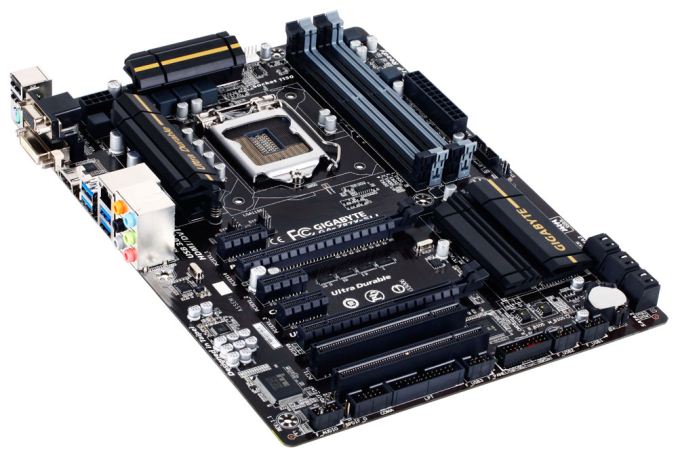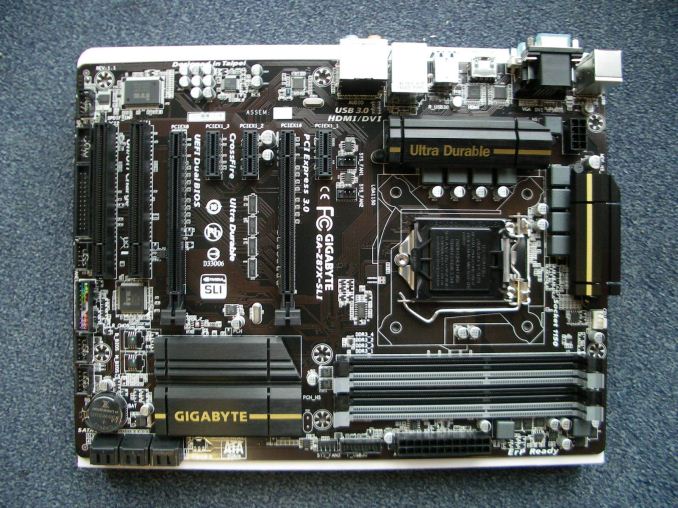GIGABYTE to Launch the Z87X-SLI
by Ian Cutress on December 2, 2013 9:20 AM EST- Posted in
- Motherboards
- Intel
- Gigabyte
- Haswell
- Z87

Hearing the name ‘Z87X-SLI’ took me aback. Z87 supports SLI already, right? Why would a manufacturer need to confirm SLI usage on the Z87 chipset: it is geared up to get the SLI license from day one. What I think GIGABYTE are going for here is a cheaper end SKU with SLI capabilities – the motherboard is devoid of all extra controllers and excess that might appear on more expensive models. There are no extra SATA 6 Gbps ports (six total), no extra USB 3.0 ports (six total), and the power delivery looks like an 8+2 affair, combined with a Realtek NIC, ALC892 audio codec and four total fan headers. The Z87X-SLI is stripped out – the only thing left would be to use a lower end chipset or not use some of the chipset features at all.
Like all Z87 GIGABYTE boards, it comes with DualBIOS and Ultra Durable 4 as standard, along with their updated BIOS and software package for Z87 which we reviewed with the Z87X-UD3H. In actual fact, looking at the UD3H alongside this Z87X-SLI shows that it is a stripped down version. Clearly there is a customer that is looking for a basic overclockable + SLI Z87 model in the market.
Pricing for the UK is set to be £95 (inc VAT), which means US pricing would be around $130. That puts it in the firing line of several Z87 Gaming motherboards as well as a few of the Z87 ITX models as well.
Source and Images from GIGABYTE UK on Facebook.


















24 Comments
View All Comments
kwrzesien - Monday, December 2, 2013 - link
It would be better to not even have the 1x slot after the first 16x slot, and move that 1x to where the first PCI slot is after the second 16x, in the case where you don't have a second gpu or it is a single-slot type. But in general they should just leave the spot next to the primary 16x empty - no one should ever use it even if they have a single-slot gpu (for cooling reasons).Gigaplex - Monday, December 2, 2013 - link
What about for single-slot waterblocks? Or very small PCIe cards that wouldn't obstruct the fan?xparty - Saturday, February 22, 2014 - link
I have a nice soundcard, I'd say. It's an M-AUDIO Delta series card that I use for audio work. It's PCI, which sucks as my workstation mobo choices are limited to what supports PCI if I choose to use it, and it has served me incredibly well over the years, and is still good as new without any niggles.For gaming, yes, there is no reason to use PCI as most of the peripherals aimed for that market are PCIe. For work however, PCI is still incredibly useful. Alternatives on the PCIe standard exist, but it's not worth it for me to shell out on an RME card in the slightest, and I still want to use the equipment that is as good as the alternatives, that I already happen to own. Z87-OC is what I use right now. I can run that sucker in SLI if I desire, and still have the option of getting work done one M-AUDIO equipment when I need to.
My personal gripe is with the manufacturers deciding to stick a ton of PCIe 1x slots that are more useless than anything else I've used in my computing career- I have no desire to use gaming audio cards for listening as I'd much rather use an external DAC+amp for that, I don't need an extensive LAN to actually necessitate more than one port on the mobo or an entire network card for that matter (my Abit IP-35 Pro has two Gbit Ethernet ports; I've only ever required one. Ever.), and a respectable RAID/SAS card will require a 4x slot anyway, if I wish to use SATA III to its full advantage. In my experience, the 1x slots are a total waste of space, while PCI slots still have very practical uses; often enough ones that can provide some income too.
Everyone's mileage varies according to their needs, is basically what I'm driving at.
Just to add, for hard CPU overclocking, having PCI slots in place of PCIe slots can be quite advantageous, as that allows you to use old barebones GPUs without interfering with the CPU so much. The Z87-OC and X58-OC were developed with that in mind, it would seem. Maybe on the Z87 it was more of a budget thing as such a 'feature' is not present on the OC Force, but it was a conscious decision for the X85-OC. These types applications and these types of boards are an different breed of beast and not really applicable in the overall discussion here, but I think it deserves to be mentioned. =)
Flunk - Monday, December 2, 2013 - link
It's strange to see them include extra hardware for legacy connections on what is meant to be a stripped down board. I can't see the benefit, they could have just moved around the 1x slots and had empty space between the two 16x slots. That layout would make more sense.kwrzesien - Monday, December 2, 2013 - link
I guess they have the space, but yes it's weird to see two PCI, VGA, LPT and COM connections. I think the whole "SLI" thing is a bit of a name-slinging what should otherwise be called the Z87X-LEGACY.DanNeely - Monday, December 2, 2013 - link
As long as there are some people who need a connector the question always comes down to if the cost of adding it on a product is greater than that of having two versions with and without or the lost sales from people who bought something else instead.The VGA output and LPT and COM headers cost very little to add since all the need to do is to add the connector hardware and route signals not add any additional controller hardware. The VGA output is provided by the chipset, and the others by the SuperIO chip (named because 20+ years ago it combined a half dozenish discrete controllers) that also connects a number of other mostly legacy devices, temperature monitoring, fan monitoring and RPM control, LPT ports, PS2 ports. (SuperIO also supports floppy and game port connections; but those are completely gone from mainstream boards). It's possible that superIO might eventually be removed entirely with it's remaining functionality moved into the southbridge; but since the size/cost of that chip is constrained by the number of pins it has shuffling the entire mess off onto a single chip that it only needs 7 pins to connect to is probably going to remain the most attractive option for Intel and AMD; especially since the TPM hangs off the same bus as does the BIOS (don't know about UEFI).
Only the PCI-PCIe bridge is a significant extra cost; and since for feature count reasons leaving card connector slots empty isn't attractive (even though the ones below the GPU slots are normally blocked) I'm not surprised that PCI slots are still present on a number of full ATX boards because there aren't enough lanes on the southbridge to connect all the supporting hardware and misc controllers and still fill all the available slots. The alternative to the PCi-PCIe bridge is probably a 4:1 PCIe mux with selection between the two being equal parts what's cheapest and/or feature check decisions. Unless future chipsets add several additional PCIe lanes I suspect we'll probably see some boards filling space with legacy PCI slots for a few more years; and with Intel's focus being increasingly on mobile where lane allocation is much less of a concern I don't see them making cpu/chipset designs more expensive only to accommodate the largest end of desktop motherboard design.
ZeDestructor - Tuesday, December 3, 2013 - link
I like RS-232 and PS2 connectivity (useful for talking to some embedded gear and using my Model M respectively).But yes, I do agree, this is much more of a SLI+Legacy board than anything..
Jay77 - Monday, December 2, 2013 - link
No, almost all Gigabyte boards have at least one, it's baffling.The Von Matrices - Monday, December 2, 2013 - link
I appreciate these stripped down boards. Modern chipsets provide enough functionality for me and a lot of others. I have no need for more than 6 SATA 6Gb/s ports and 6 USB 3.0 ports, but I am forced to buy boards with 10 SATA ports and 14 USB 3 ports that I will never use because manufacturers bundle them in to boards with the other features I want (3x PCIe x16 slots, for example).I want manufacturers to make at least one model that takes a high end chipset (z87, for example) and includes every feature the chipset supports but nothing more. In this case, 3 x PCIe x16, 6 SATA 6Gb/s, 6 USB 3.0, 6 PCIe x1 (or 1 PCIe x4 + 2 PCIe x1), Intel LAN PHY, and ALC1150 HD Audio. This would be the perfect board for me. I have no need for add on controllers beyond what the chipset supports, and I suspect that many will agree with me.
kwrzesien - Monday, December 2, 2013 - link
At first I thought it must be a mATX to bother advertising SLI in the name, that would be more interesting.